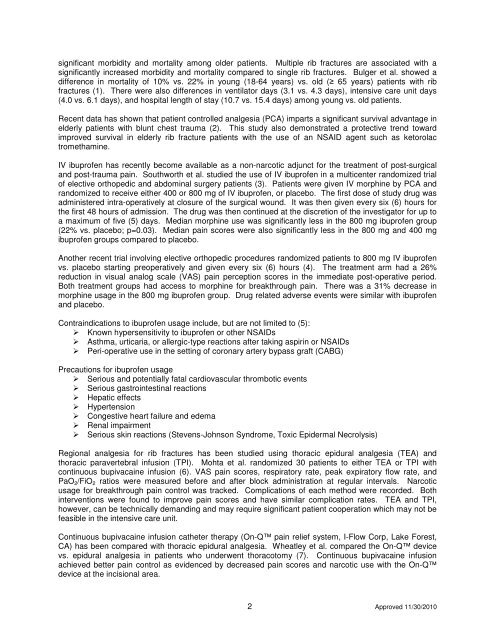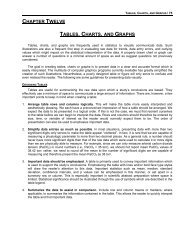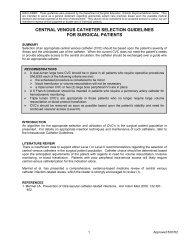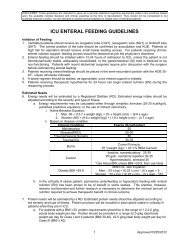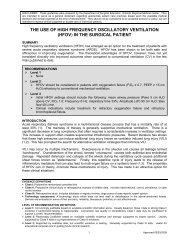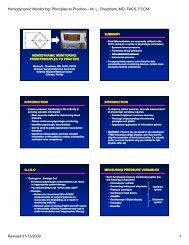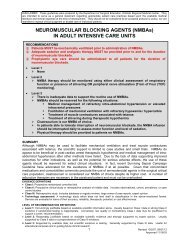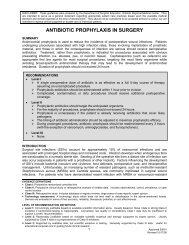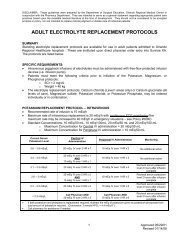multi-modality pain control for rib fractures - SurgicalCriticalCare.net
multi-modality pain control for rib fractures - SurgicalCriticalCare.net
multi-modality pain control for rib fractures - SurgicalCriticalCare.net
You also want an ePaper? Increase the reach of your titles
YUMPU automatically turns print PDFs into web optimized ePapers that Google loves.
significant morbidity and mortality among older patients. Multiple <strong>rib</strong> <strong>fractures</strong> are associated with asignificantly increased morbidity and mortality compared to single <strong>rib</strong> <strong>fractures</strong>. Bulger et al. showed adifference in mortality of 10% vs. 22% in young (18-64 years) vs. old (≥ 65 years) patients with <strong>rib</strong><strong>fractures</strong> (1). There were also differences in ventilator days (3.1 vs. 4.3 days), intensive care unit days(4.0 vs. 6.1 days), and hospital length of stay (10.7 vs. 15.4 days) among young vs. old patients.Recent data has shown that patient <strong>control</strong>led analgesia (PCA) imparts a significant survival advantage inelderly patients with blunt chest trauma (2). This study also demonstrated a protective trend towardimproved survival in elderly <strong>rib</strong> fracture patients with the use of an NSAID agent such as ketorolactromethamine.IV ibuprofen has recently become available as a non-narcotic adjunct <strong>for</strong> the treatment of post-surgicaland post-trauma <strong>pain</strong>. Southworth et al. studied the use of IV ibuprofen in a <strong>multi</strong>center randomized trialof elective orthopedic and abdominal surgery patients (3). Patients were given IV morphine by PCA andrandomized to receive either 400 or 800 mg of IV ibuprofen, or placebo. The first dose of study drug wasadministered intra-operatively at closure of the surgical wound. It was then given every six (6) hours <strong>for</strong>the first 48 hours of admission. The drug was then continued at the discretion of the investigator <strong>for</strong> up toa maximum of five (5) days. Median morphine use was significantly less in the 800 mg ibuprofen group(22% vs. placebo; p=0.03). Median <strong>pain</strong> scores were also significantly less in the 800 mg and 400 mgibuprofen groups compared to placebo.Another recent trial involving elective orthopedic procedures randomized patients to 800 mg IV ibuprofenvs. placebo starting preoperatively and given every six (6) hours (4). The treatment arm had a 26%reduction in visual analog scale (VAS) <strong>pain</strong> perception scores in the immediate post-operative period.Both treatment groups had access to morphine <strong>for</strong> breakthrough <strong>pain</strong>. There was a 31% decrease inmorphine usage in the 800 mg ibuprofen group. Drug related adverse events were similar with ibuprofenand placebo.Contraindications to ibuprofen usage include, but are not limited to (5): Known hypersensitivity to ibuprofen or other NSAIDs Asthma, urticaria, or allergic-type reactions after taking aspirin or NSAIDs Peri-operative use in the setting of coronary artery bypass graft (CABG)Precautions <strong>for</strong> ibuprofen usage Serious and potentially fatal cardiovascular thrombotic events Serious gastrointestinal reactions Hepatic effects Hypertension Congestive heart failure and edema Renal impairment Serious skin reactions (Stevens-Johnson Syndrome, Toxic Epidermal Necrolysis)Regional analgesia <strong>for</strong> <strong>rib</strong> <strong>fractures</strong> has been studied using thoracic epidural analgesia (TEA) andthoracic paravertebral infusion (TPI). Mohta et al. randomized 30 patients to either TEA or TPI withcontinuous bupivacaine infusion (6). VAS <strong>pain</strong> scores, respiratory rate, peak expiratory flow rate, andPaO 2 /FiO 2 ratios were measured be<strong>for</strong>e and after block administration at regular intervals. Narcoticusage <strong>for</strong> breakthrough <strong>pain</strong> <strong>control</strong> was tracked. Complications of each method were recorded. Bothinterventions were found to improve <strong>pain</strong> scores and have similar complication rates. TEA and TPI,however, can be technically demanding and may require significant patient cooperation which may not befeasible in the intensive care unit.Continuous bupivacaine infusion catheter therapy (On-Q <strong>pain</strong> relief system, I-Flow Corp, Lake Forest,CA) has been compared with thoracic epidural analgesia. Wheatley et al. compared the On-Q devicevs. epidural analgesia in patients who underwent thoracotomy (7). Continuous bupivacaine infusionachieved better <strong>pain</strong> <strong>control</strong> as evidenced by decreased <strong>pain</strong> scores and narcotic use with the On-Qdevice at the incisional area.2 Approved 11/30/2010


